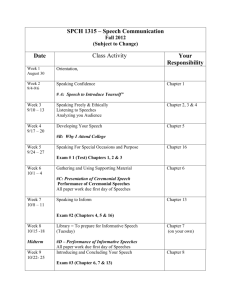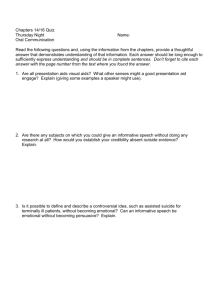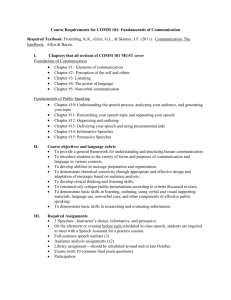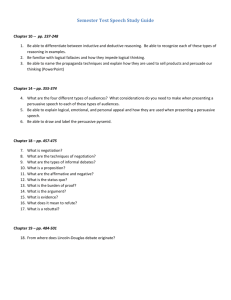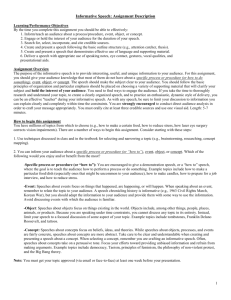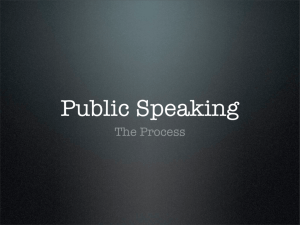COMMUNICATION 3101, PUBLIC SPEAKING
advertisement
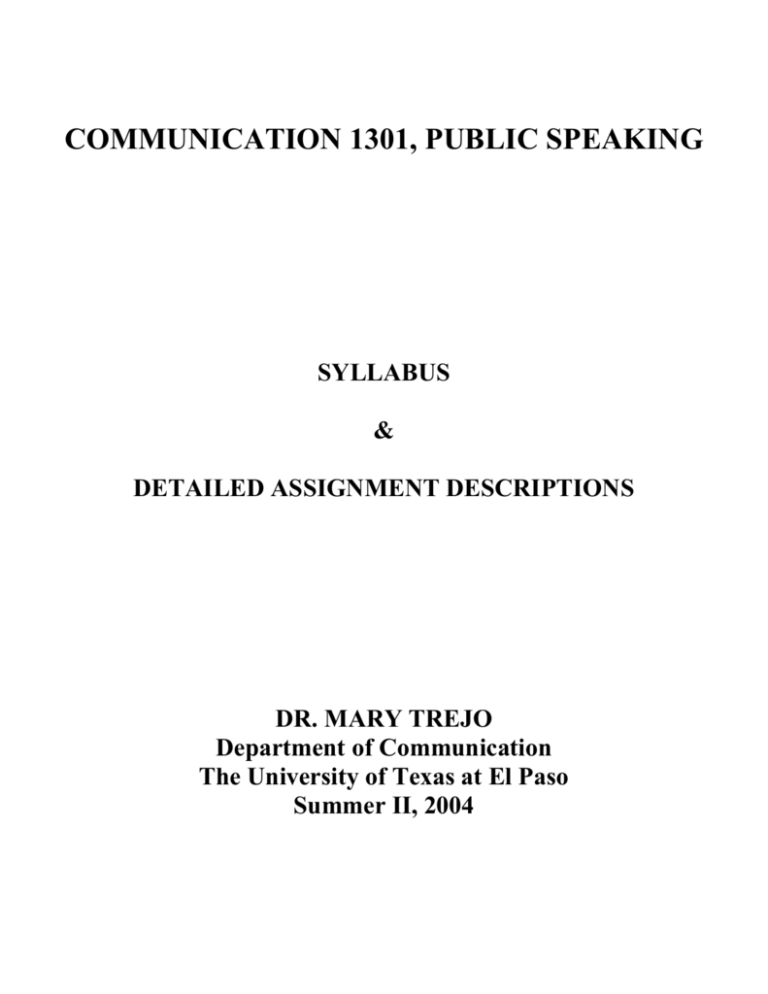
COMMUNICATION 1301, PUBLIC SPEAKING SYLLABUS & DETAILED ASSIGNMENT DESCRIPTIONS DR. MARY TREJO Department of Communication The University of Texas at El Paso Summer II, 2004 2 COMMUNICATION 1301 #32583, Summer II, 2004 Classroom: Cotton 201 Dr. Mary C. Trejo, Instructor Office: Cotton 102; Phone, 747-5431; email, MTrejo@OzarkLand.com Office Hours, MTWR 4:10-5:00 PM; by appointment Course Texts: Stephen Lucas, The Art of Public Speaking, 7th Ed. Isa Engleberg & Ann Raimes, Pocket Keys for Speakers. OVERVIEW OF SEMESTER: This course provides an introduction to the art of public speaking. The major grading emphasis is on the conception, development, and logical communication of ideas. The course will be designed or modified as a result of diagnostic analysis utilized during the initial meetings. The planning of assignments reflects the adult status, wideranging interests, intelligence, and good mastery of language skills expected of college students. Students are anticipated to be mature and well prepared to take responsibility for preparation and completion of assignments. Students are expected to manage their time effectively and provide self-motivation in completing assigned readings and speeches, and to be ready to participate in text discussions each day. In addition to taking responsibility for completing readings and speech preparations, students will be encouraged to select real-world topics of substantive interest that call for challenging research and idea development. Both hard work and creativity will be rewarded. Detailed explanations of all assignments will be provided as the semester progresses. If clarifications are needed, students are encouraged to ask questions whenever they wish. As the primary objective of the course is to teach students to speak in formal settings, by the end of the course, students are expected to be able to meet the following objectives: Learn to transform nervousness into an effective presentation Conceptualize, focus and develop a topic into a meaningful, purposeful communication Understand the organizational components of a speech Organize logically and develop ideas fully, utilizing examples and analysis Develop research skills utilizing the library and the internet Speak in a natural, extemporaneous manner without reading from a text PROJECTED COURSE OVERVIEW; SUBJECT TO MODIFICATION AS NEEDED: Week 1: June 28-July 2 Introduction; Assigned reading: Lucas, Chapters. 1-5, 11-12. Focus on fundamentals of public speaking. Text Discussions begin June 29 and continue throughout session. Assignment #1, Descriptive/Narrative Speech, due July 1 Week 2: July 5-9 NOTE: Drop deadline with W is Friday, July 9! Continue assigned reading: Lucas, Chapters 6-10, 14. Focus on organization and logic; introduction to informative speaking and library/internet research. Assignment #2, Midterm Examination over Lucas text readings, July 8 Week 3: July12-16 Assigned reading: Lucas, Chapters 15-16; focus on persuasion and refining idea development and delivery. Assignment #3, Informative Speech, due July 12 Assignment #4, Persuasive Speech, due July 16 Week 4: July 19-23 Assigned reading: Lucas, Appendix B, B-1 to B-20; bringing it all together; synthesis of skills learned. Assignment #5, Persuasive/Motivational Speech, due July 22 Week 5: Assignment #6, Final Examination, June 27, 10:00 AM-12:45 PM, Cotton 201 3 SPECIFIC REQUIREMENTS OF THE COURSE: # 1, Descriptive/Narrative Speech # 2, Midterm exam over Lucas text # 3, Informative Speech # 4, Persuasive Speech # 5, Persuasive/Motivational Speech # 6, Final exam 100 Points 100 Points 200 Points 200 Points 300 Points 100 Points due July1 July 8 due July 12 due July 16 due July 22 July 26, 10 AM-12:45 PM GRADING SCALE--TOTAL: 1000 Points 1000- 900 A 899- 800 B 799- 700 C 699- 600 D 599 & below F ABSENCE POLICY: Over 3 unexcused absences will result in being dropped from the class or, after the drop date, a lowered grade. Only documented excuses will be accepted. NOTES ON PREPARATION AND DOCUMENTATION OF SPEECHES: Each graded speech assignment includes formal documentation: a typed title page, outline, and, for the Informative, Persuasive, and Persuasive/Motivational speeches, documentation of research. The due dates for your formal outline packets are at the beginning of class on the first day speeches are due for each assignment. The instructor will call on students in random order to perform speeches after all students have handed in the outline packets to demonstrate their preparedness. Lateness will result in a lowered grade, with extenuating circumstances being considered on a case-to-case basis. SEMESTER READING ASSIGNMENTS From Lucas, The Art of Public Speaking, 7th Ed. NOTE: In a 20-day summer session, it is necessary to keep up with assigned reading in order to derive maximum benefit from course instruction. Most of the readings are grouped in the first half of the session; please schedule your time carefully! You are asked to read for comprehension and mastery of concepts. The midterm examination will cover the following chapters from Lucas: Chapters 1-12, 14-16. The final examination will cover all chapters assigned: Lucas, Chapters 1-5, 11, 12, 6-10, 14, 15, 16, and Appendix B. (Chapters presented in the order assigned, above.) IN ADDITION, the final will cover selected materials (to be announced later) from Engleberg & Raimes, Pocket Keys for Speakers. Week 1: Chapters 1-5, 11, 12 Week 2: Chapters 6, 8, 9, 10; also read 6 & 7 to prepare for research, and read Chapter 14 early to prepare for Informative Speaking Week 3: Chapters 15 & 16; should be read early to prepare for Persuasive Speaking Week 4: Appendix B, pgs. B-1 to B-20; try to read these excellent model speeches earlier in the semester if you possibly can! 4 COMMUNICATION 3101, PUBLIC SPEAKING ASSIGNMENT DESCRIPTION: #1, EXPRESSIVE/ DESCRIPTIVE NARRATIVE SPEECH (150 Points) Time limit: 3-5 minutes; brief typed outline with title page required, utilizing standard English mechanics. Your objective is to plan, practice, and deliver a speech of approximately 3-5 minutes, using brief notes. This first formal speech assignment asks you to tell a story in an expressive, descriptive way. You are asked to plan, briefly outline, and tell a descriptive personal story. Childhood memories or old family stories are good topics. In selecting what story to tell, keep it simple; you may simply tell about some event that you or some member of your family experienced. Remember your ethical responsibility to your audience, and keep the stories non-offensive. It is often a good idea to concentrate on happy topics or memories. This is intended to be an easy to approach, icebreaker exercise, so choose a topic that you will enjoy sharing with your audience. Your speech should have three main sections: (1) an introduction, in which you establish interest and preview, (2) a body, in which you develop your story, and (3) a conclusion, in which you summarize. You may look at your brief outline while speaking, but DO NOT READ ALOUD FROM A WRITTEN TEXT. Your objective is to speak naturally and directly to your audience. Plan an introduction, a body, and a conclusion for your speech. Include interesting details. Sensory descriptions will make these speeches more vivid. Remember the five senses—sight, hearing, taste, smell and touch. Using at least some of the five senses in your speech will make it more memorable. Notes should be brief, easy to read, should occupy no more than one side of a 4x6 note card. A 1-page photocopy of this card must be handed in before your speech. Speak extemporaneously; utilize good delivery skills such as good eye contact, poise, and vocal variety; review Chapter 12, Delivery, before this assignment. Be brief--plan, practice, and time your speech to fit the time limit. Make sure your speech is well prepared--this instruction speaks for itself! Adapt your remarks to the audience--assume your audience is comprised of intelligent adults. Relax, enjoy yourself, and feel free to be a little creative. Public speaking can be fun! 5 COMMUNICATION 3101, PUBLIC SPEAKING ASSIGNMENT DESCRIPTION: #3, INFORMATIVE SPEECH (200 POINTS) Time limit: 5 minutes Outline with title page, works cited page and attached photocopied sources (with material cited highlighted) must be handed in before delivering speech. Speaker’s outline and specific source citations may be used at the podium. RESEARCH REQUIREMENT: 3 SOURCES , MINIMUM The task in Assignment # 3 is to select a researchable topic and plan and deliver a five-minute informative speech, utilizing library and internet research. You are advised to start early to enable you to research, plan, practice, and deliver a well thought-out informative speech, using very brief notes. Review Lucas, Chapter 14, Speaking to Inform, for specific instructions; follow these guidelines carefully. Special assignment adaptations are as follows: Type of Informative--Announce before you begin your speech which type of informative speech you have chosen (See Lucas, Ch. 14, on speeches about Objects, Processes, Events, or Concepts.) You may not choose Processes, or Process Analysis, for your speech. Please choose from the other types (Objects, Events or Concepts) of Informative Speaking. Topic/Research--Choose a topic that fulfills your speaker’s ethical responsibility to the audience, which interests you and which can be researched. Find and photocopy or print out at least three research sources to be cited. At least one paraphrase and one verbatim quotation with clear and accurate citations from at least two of the three sources should be used in the speech. Therefore, a minimum number of four clear citations of research are required in the speech. Note cards with research items to be cited may be used in addition to the brief speaking outline. Note cards should be cut and pasted from photocopies or printouts. Outline--Before you speak, hand in a two-level (roman numerals and capital letters) sentence or phrase outline with works cited page and photocopies attached. Include a title page. This outline will be graded on neatness and clarity; word processing or typing is mandatory. The speech should be delivered extemporaneously from a brief speaking outline and research note cards. Hand in the speaking outline, printouts, photocopies and note cards at the end of your speech so that they may be evaluated along with the formal outline previously handed in. The formal outline, Works Cited page and photocopies/printouts will be considered part of the preparation for the speech and will represent 1/3 of the grade for this assignment. Outlines should exemplify good grammar and spelling; MLA (Modern Language Association) works cited or bibliography form should be used. Remember, this is a formal speech; therefore, you will want to utilize text chapters covered which deal with all components of good public speaking, including those on organization, idea development, research, introductions and conclusions, good language use, and delivery. Start early, plan ahead, and practice, practice, practice. REMINDER: Photocopies should be clearly highlighted, (use fluorescent highlighter, so that the photocopies can be reused with another photocopying) with notations stating whether cited material is quoted verbatim or paraphrased. Instructions for highlighting research materials will be given in class. 6 COMMUNICATION 3101, PUBLIC SPEAKING ASSIGNMENT DESCRIPTIONS FOR ASSIGNMENT #s 4 and 5, PERSUASIVE SPEECHES #4 Persuasive Speech (5-7 minutes) on a Question of Fact or Value, (200 Points) #5 Persuasive/ Motivational Speech (5-7 minutes) new topic, on a Question of Policy, (300 Points) Mastering the logic and organizational skills essential to the creation of a successful persuasive speech will provide you with a selection of strategies of idea development, which will be helpful in diverse areas. In order to prepare fully for the final assignments of the semester, please review Lucas, Chapter 15, Speaking to Persuade, and Chapter 16, Methods of Persuasion, carefully; Lucas provides specific and excellent instructions for mastering the art of persuasion. Remember, the motto of the national forensics organization, PI KAPPA DELTA, is "the art of persuasion, beautiful and just." Please note that there are three main types of persuasive formats: these are (1) Speeches or essays on questions of fact (2) Speeches or essays on questions of value (3) Speeches or essays on questions of policy (often called motivational because they are intended to motivate the audience to, at the least, agreement, and often, to direct action) Assignment # 4 asks you to choose to produce a persuasive speech on a question either of (1) fact, or (2) value. Assignment # 5 asks you to produce a persuasive/motivational speech on a question of policy; since your objective is to motivate your audience to agreement or action, you are asked to utilize emotional appeal in addition to using evidence and reasoning. Chapters 15 and 16 provide excellent explanations and samples of these types and methods of persuasion. For both assignments you are specifically asked to utilize evidence and reasoning as discussed in Ch. 16. Topics--As in all earlier assignments, the type and format of the exercise is assigned; you choose the specific topics to research and develop. Choose a topic about which you are knowledgeable and that can be researched (remember, research is optional on # 5) without too much trouble. Be sure to remember that, while the topic for persuasion is always of necessity controversial to some degree, you are advised not to choose a highly sensitive or emotionally charged topic which is likely to offend your classmates or which will, by its very nature, make you nervous or uncomfortable. Keep your ethical responsibility to your audience in mind. Audience--Use the actual class as your audience. 7 Assignment Descriptions for #4 and #5, Persuasive Speeches, continued Specific Instructions for Outlines for Persuasive Speech Assignments: (1) Before you speak, hand in a formal outline, which is defined as a two-level (roman numerals and capital letters) complete sentence outline with title page, works cited page and photocopies attached. This outline will be graded on logical organization of ideas, grammar, neatness and clarity. Typing/ word processing is required. All persuasive assignments (speeches and essays) will include formal outlines that follow the same guidelines. (2) The speaker's outline is much more informal and should be planned to be easy to read at a glance. DO NOT READ ALOUD FROM AN ESSAY-TYPE MANUSCRIPT! Only very brief speaker's notes in the form of a word or phrase outline (1 page maximum) may be used; note cards may be used only to present verbatim quotations to be read aloud in the speech to demonstrate your research. The speech should be delivered in a natural, extemporaneous style from the brief speaking outline and limited research note cards. Hand in the speaking outline and photocopies, printouts and note cards at the end of your speech so that they may be evaluated along with the outline previously handed in. Outlines will be considered part of the preparation for the speech. Outlines should exemplify good grammar and spelling; Works Cited form should be MLA. MLA in-text documentation must be used in the outline. Proofread all pages, including verbatim quotations, carefully! Research--Required on # 4; optional on # 5. For #4, find and photocopy or print out at least four research sources to be cited. Plan to use at least one paraphrase and one verbatim quotation from each source. Give accurate citations in the speech. Mark the location of these research citations in colored pen or highlighter on your formal outline and on your speaker's outline and on your photocopies; example: write a simple note such as "paraphrase 1" or "quotation 3" next to specific outline entries and on photocopies. Post-it notes attached to photocopy pages used are helpful. For speech #s 4 and 5: these are formal speeches; therefore, you will want to utilize text chapters covered which deal with all components of good public speaking, including those on organization, idea development, research, introductions and conclusions, good language use, and delivery. Be sure to look up and practice pronunciation of new words. Start early, plan ahead, and be sure to PRACTICE your speech at home, using a timer, until you are comfortable. 8 COMMUNICATION 1301, PUBLIC SPEAKING DESCRIPTION: PRACTICE SPEAKING: TEXT DISCUSSIONS Time Limit: Approximately 10 minutes As part of the warm-up exercises designed to help you to relax while speaking in public, and to serve the purpose of focusing the attention of the class on the assigned readings in the text book, you may be asked to lead a class discussion of approximately 10 minutes on one text book chapter. The educational philosophy behind this assignment and others like it is simple: that people learn more when they are actively engaged in absorbing and practicing the messages contained in class materials than when they are passive listeners. Speakers: Please keep up with the Lucas text readings assigned each week. The instructor will call on students randomly to conduct text discussions due that week. Please be sure to be prepared to speak when called upon! Audience: All must listen actively and interact with the speaker. You may be required to answer questions, participate in surveys, or make comments at the end of the presentation. Speakers will need to plan an informal outline to help in remembering important ideas. Also, this is an open book presentation—feel free to quote from the text. Remember, as a discussion leader, you have the right to plan questions to ask the class. You may also feel free to ask the instructor to help you during this warm-up exercise. This is an informal exercise; you may either sit or stand at the front of the room, depending on your professor’s instructions. You should speak clearly and distinctly and make an effort to share the important ideas from the chapter with the class. If you are able to elicit discussion from the class, this is a mark of success, so plan strategies to get the class to talk! 9 COMM 1301 SPEECH GRADE SHEET Assignment #________________ Name_______________________ TOPIC APPROPRIATE AND SUFFICIENTLY FOCUSED: DELIVERY SKILLS: A. EYE CONTACT B. VOICE--VOLUME, VOCAL VARIETY, PACE C. POISE/ BODY LANGUAGE LOGICAL STRUCTURE OF SPEECH: I. II. INTRODUCTION A. LEAD-IN/ JUSTIFICATION OF TOPIC B. THESIS/ SPECIFIC PURPOSE CLEARLY IDENTIFIED C. CLEAR PREVIEW OF MAJOR POINTS BODY OF SPEECH (DEVELOPMENT & SUPPORT OF IDEAS) A. B. III. LOGIC AND ORGANIZATION 1. LOGICAL THESIS/ SPECIFIC PURPOSE WITH MAJOR POINTS 2. SAME MAJOR POINTS USED IN THESIS/OUTLINE/SPEECH 3. CLEAR ORGANIZATION 4. CUMULATIVE TRANSITIONS SUPPORTING MATERIALS 1. CLEAR DOCUMENTATION OF RESEARCH SOURCES 2. CITATION OF SPECIFIC, GRAPHIC EXAMPLES 3. FULL DEVELOPMENT OF IDEAS CONCLUSION A. DETAILED SUMMARY B. RESTATEMENT OF THESIS/ SPECIFIC PURPOSE C. FOCUS ON SPECIFIC PURPOSE, USING MEMORABLE LANGUAGE Grade___________ 10 EXERCISE IN LISTENING —RATING FORM Rate your classmates: 1=excellent; 2=OK; 3= needs improvement (Source: Lucas, p. 68) Speaker________________________________ Topic_______________________________ INTRODUCTION: ___ Gained attention and interest DELIVERY: ___ Began speech without rushing ___ Introduced topic clearly ___ Maintained strong eye contact ___ Related topic to audience ___ Avoided distracting mannerisms ___ Established speaker’s credibility ___ Articulated words clearly ___ Previewed body of speech ___ Used pauses effectively ___ Used vocal variety to add impact BODY: ___ Presented visual aids well ___ Made main points clear ___ Departed from lectern without rushing ___ Fully supported main points ___ Organized the material well ___ Used accurate language OVERALL EVALUATION: ___ Used clear language ___ Chose a challenging topic ___ Used appropriate language ___ Chose the specific purpose well ___ Used effective connectives ___ Adapted message to audience ___ Held interest of audience CONCLUSION: ___ Prepared audience for ending ___ Reinforced central idea of speech ___ Presented vivid ending SUGGESTIONS FOR IMPROVEMENT: 11 A MASTER PLAN FOR EFFECTIVE PAPERS AND SPEECHES The following is a detailed plan for outlines and for the papers and/or speeches that these outlines organize; it is not an outline itself. Please consult your text for correct forms and typing format for formal outlines. This plan for a thesis sentence and outline format supercedes other instructions; for example, you are required to outline introduction and conclusion sections even though some texts do not do so. Please consider this format your master plan for major assignments in this course. Minor modifications are acceptable, but please adhere to the major concepts and procedures outlined below. **************************************************** Sample: TITLE (compose a nicely worded title which fits your topic) Thesis: ____ is (or should be) ____, because of major point # 1, major point #2 and major point #3. (Note: The thesis is traditionally placed at the top of the outline just under the title to indicate that it is the controlling thought for the entire outline and subsequent essay or speech; do not state the thesis first in either an essay or speech.) INTRODUCTION: (Roman Numeral I) This section, usually 1-2 minutes in ten-minute speeches and ½ to 1 page in short papers of under 10 pages, should: Justify your topic in an interesting lead-in discussion Introduce, identify and state the thesis to be proved Preview the major points to be covered; do not simply repeat the major arguments, or points of proof, from your thesis. Preview briefly, with some detail, how you will prove your thesis, being sure to let the audience know that you are previewing and have not yet begun the body of your argument. The preview is mandatory for speeches and desirable for essays. TRANSITION from introduction to body; transitions may appear on the outline; they are vital to the coherence of your project. BODY OF ARGUMENT: (This section will include Roman Numerals II, III, and optionally IV and V, depending on how many proof points the thesis states. The numbering, subject matter and even the wording of the body roman numerals should directly correspond to the major proof points of the thesis.) 12 Sample Major Point Development: II. ____ is (or should be) ____ because of major point #1. A. Supporting example 1. Introduce supporting example 2. State the actual example (quotation, paraphrase, etc.) 3. Analyze, comment upon, explain example 4. Relate example to major point #1, showing how this relates to and supports the thesis. TRANSITION into next example (II., B.) Always use transitions between examples or between stages in the progression of your logic. Only major transitions have been included in the rest of this sample, as minor transitions needed are too numerous to list. B. Supporting example (See II., A., above) Use as many supporting examples as you have time or space for, being sure to maintain symmetry between parts. CUMULATIVE TRANSITION into major point #2 III. ____ is (or should be) ____ because of major point #2. A. Supporting example (See II., A., above) B. CUMULATIVE TRANSITION into major point #3 IV. ____ is (or should be) ____ because of major point #3. A. Supporting example (See II., A., above) B. CUMULATIVE TRANSITION into Conclusion CONCLUSION: (Roman Numeral V in an outline which develops three major points) This section, usually 1 minute in short speeches and ½ to 1 page in papers under 10 pages, should: Summarize the major points in some detail, showing that they have been proved or successfully discussed Restate the thesis, showing that it has been proved or successfully discussed End the analysis powerfully, using pleasing wording (aesthetic appeal), and satisfying logic (intellectual appeal); emotional appeal may be used as well. Reminder: never introduce a new argument in the conclusion.

